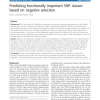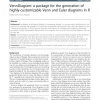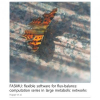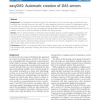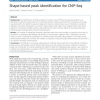BMCBI
2011
13 years 10 months ago
2011
Background: With the advent of cost-effective genotyping technologies, genome-wide association studies allow researchers to examine hundreds of thousands of single nucleotide poly...
BMCBI
2011
13 years 10 months ago
2011
Background: In order to interpret the results obtained from a microarray experiment, researchers often shift focus from analysis of individual differentially expressed genes to an...
BMCBI
2011
13 years 10 months ago
2011
Background: Visualization of orthogonal (disjoint) or overlapping datasets is a common task in bioinformatics. Few tools exist to automate the generation of extensively-customizab...
BMCBI
2011
13 years 10 months ago
2011
Background: The increasing availability of molecular sequence data means that the accuracy of future phylogenetic studies is likely to by limited by systematic bias and taxon choi...
BMCBI
2011
13 years 10 months ago
2011
BMCBI
2011
13 years 10 months ago
2011
Background: Caenorhabditis elegans gene-based phenotype information dates back to the 1970’s, beginning with Sydney Brenner and the characterization of behavioral and morphologi...
BMCBI
2011
13 years 10 months ago
2011
Background: The Distributed Annotation System (DAS) has proven to be a successful way to publish and share biological data. Although there are more than 750 active registered serv...
BMCBI
2011
13 years 10 months ago
2011
Background: The identification of binding targets for proteins using ChIP-Seq has gained popularity as an alternative to ChIP-chip. Sequencing can, in principle, eliminate artifac...
BMCBI
2011
13 years 10 months ago
2011
Background: Building repositories of computational models of biological systems ensures that published models are available for both education and further research, and can provid...
BMCBI
2011
13 years 10 months ago
2011
Background: With continuing identification of novel structured noncoding RNAs, there is an increasing need to create schematic diagrams showing the consensus features of these mol...
